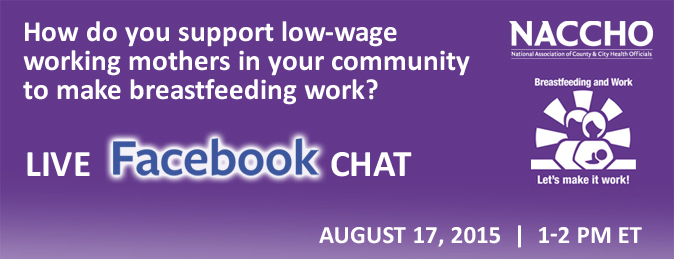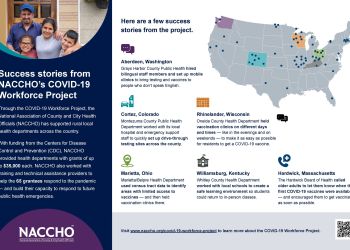By NACCHO’s Safe & Healthy Families Team
August is National Breastfeeding Month, a time to focus on promoting and protecting breastfeeding in the United States. Public health workers hope to use the month-long spotlight to generate awareness about the importance of breastfeeding, help ensure access to necessary lactation care and services for all women, including those in the workforce, and support all present and future breastfeeding mothers.
Breastfeeding is one of the most effective ways mothers can prevent disease and protect the health of their infants. Optimal infant feeding is exclusive breastfeeding for six months, and continued for at least one year or longer, with age-complementary feeding. Research has revealed numerous advantages to breastfeeding such as the following:1
- Nutrition/health benefits: Breast milk provides all the necessary nutrients and antibodies, unparalleled by formula, which enable optimum development and protect babies from many diseases. Nursing mothers also benefit; breastfeeding is linked to a lower risk of type 2 diabetes, breast cancer, ovarian cancer, and postpartum depression.
- Increased mother-baby bonding: The physical contact between the newborn and mother helps the baby feel warm and secure and can also boost the mother’s oxytocin level.
- Cost: Breastfeeding saves time and money. Formula and feeding supplies can cost over $1,500 per year, in addition to the time and effort spent buying, making, and cleaning bottles and nipples. A recent study shows that the United States would save $13 billion per year if 90% of families breastfed exclusively for six months.2 Breastfed infants typically require less medical care and have lower costs.
Although breastfeeding rates have increased across all groups, racial and socioeconomic disparities still exist. African-American women have the lowest breastfeeding initiation and duration rates of all racial and ethnic groups (50% lower than Caucasian infant rates).2 In order to close the breastfeeding gap, local health departments (LHDs) must identify and provide access to breastfeeding support, programs and services, and education for their communities.
In 2014, the Centers for Disease Control and Prevention (CDC), Division of Nutrition, Physical Activity, and Obesity, funded the NACCHO breastfeeding initiative for four years. The purpose of the Reducing Breastfeeding Disparities through Peer and Professional Support project is to increase the implementation of breastfeeding services, such as support groups, home visits, and individual counseling for African American women and underserved communities, and to develop community partnerships to support breastfeeding. Through the Breastfeeding Project, NACCHO has currently funded 63 organizations (including 20 local health departments) to provide evidence-based and innovative breastfeeding programs and services to mothers and their infants in 32 states and some U.S. territories. To learn more about the Breastfeeding Project, visit http://breastfeeding.naccho.org.
 NACCHO Breastfeeding Project Team invites its grantees and other LHDs to participate in a live Facebook chat event on August 17, 1:00–2:00 PM EDT, on the NACCHO Facebook page. The topic is “Breastfeeding and Work: Let’s Make it Work for Low-Wage Working Moms in Your Community,” which is also the theme for this year’s awareness campaign. Follow NACCHO on Facebook to learn more.
NACCHO Breastfeeding Project Team invites its grantees and other LHDs to participate in a live Facebook chat event on August 17, 1:00–2:00 PM EDT, on the NACCHO Facebook page. The topic is “Breastfeeding and Work: Let’s Make it Work for Low-Wage Working Moms in Your Community,” which is also the theme for this year’s awareness campaign. Follow NACCHO on Facebook to learn more.
References
- Office on Women’s Health. (2011). Your Guide to Breastfeeding. Washington, DC: Department of Health and Human Services.
- Office of the Surgeon General. (2011). The Surgeon General’s Call to Action to Support Breastfeeding. Washington, DC: Department of Health and Human Services.






